Gonatus berryi
Tsunemi Kubodera, F. G. Hochberg, and Richard E. YoungIntroduction
Gonatus berryi is a relatively common and distinctive species. It reaches a maximum size of at least 240 mm ML.

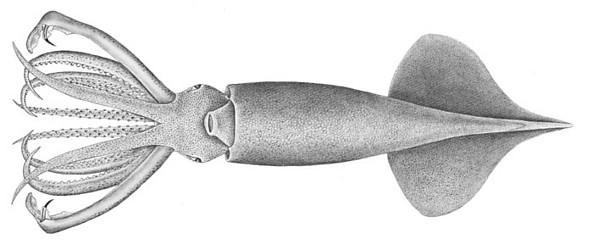
Figure. Ventral view of G. berryi, 119 mm GL. Drawing from Young (1972).
Brief diagnosis:
A Gonatus with ...
- club hooks proximal to the central hook that become larger toward the base of the club.
- virtually no suckers in the medial region of the tentacular stalk.
Characteristics
- Arms
- Number of suckers in proximal half of each arm IV at 50 mm GL = about ??, and at 119 mm GL = about 45.
- Tentacles
- Clubs unusually large, 30-37% of GL. Note large club size in title photographs.
- Club dactylus with 4 sucker series becoming disorganized at dactylus base where sucker series split into those leading to the marginal zones of club.
- Club ventral-marginal zone with 3 series of suckers in central region; medial suckers ca. one-fourth diameter of suckers of marginal series. Occasionally 1-2 small suckers present as a partial fourth series.
- Club dorsal-marginal zone with few suckers in 1-2 irregular series.
- Club medial zone with large central hook; small distal hook and proximal series with 1-2 suckers followed proximally by 2-4 small hooks with largest hook never closest to large central hook (i. e. hooks initially increase in size proximally).
- Total number of suckers (excluding terminal pad, medial zone) on tentacular club: about 159-181.
- Median region of tentacular stalk between marginal series without suckers except for occasional 1-2 sucker.
 Click on an image to view larger version & data in a new window
Click on an image to view larger version & data in a new window
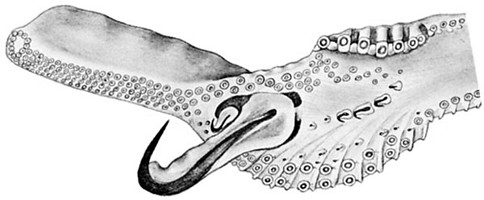
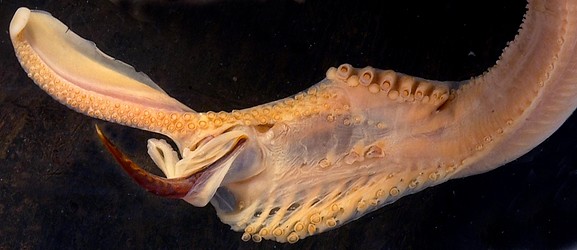
Figure. Oral views of the tentacle and club of G. berryi 119 mm GL, plesiotype. Top - Left tentacle. Middle- Enlargement of the tentacular club. Drawings from Young (1972). Bottom - Right tentacular club. Photograph by R. Young. The drawings have been inverted for easier comparison with the photograph.
- Clubs unusually large, 30-37% of GL. Note large club size in title photographs.
- Head
- Beaks. Descriptions can be found here: Lower beak; upper beak. See also this site.
- Fins
- Fins large, ca. 50% of PL.
- Fins large, ca. 50% of PL.
- Photophores
- Photophores absent
Comments
More details of the description of G. berryi can be found here.
G. berryi, in addition to the features listed above, can generally be recognized by the large size of the central hook, the large club manus and narrow dactylus and the somewhat more distal position of the central hook.
Life History
The advanced paralarva of G. berryi at 8-10 mm ML has a spherical digestive gland rather than the spindle-shaped, obliquely-oriented digestive gland common to paralarvae of many (all?) other members of the genus.

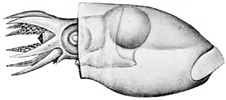
Figure. Side view of a paralarva of G. berryi, 10 mm ML. Drawing from Young (1972).
The size of the juvenile at which the various hooks first develop is often distinctive of the species.
Distribution
Type locality: Monterey Bay, California, eastern North Pacific. G. berryi is broadly distributed across the North Pacific.References
Okutani, T., T. Kubodera and K. Jefferts. 1983. Diversity, distribution and ecology of gonatid squids in the subarctic Pacific: A review. Bull. Ocean Res. Inst., Univ. Tokyo, No. 26 (1):150-192.
Young, R. E. 1972. The systematics and areal distribution of pelagic cephalopods from the seas off Southern California. Smithson. Contr. Zool., 97: 1-159.
Title Illustrations

| Scientific Name | Gonatus berryi |
|---|---|
| Location | Eastern North Pacific off Monterey, California at about 36.7°N, 122.1°W |
| Comments | In situ photographs taken at depths of 736 m (left photograph) and 1080 m (right photograph. Note that in the left photograph the tentacles appear to be locked together at the club base and club tip. |
| Acknowledgements | Image courtesy of the Monterey Bay Aquarium Research Institute (MBARI). You must obtain permission from MBARI to use this photo; please contact pressroom@mbari.org for further information. |
| Identified By | R. E. Young |
| Behavior | Two G. berryi showing the Dorsal Arm-curl posture. Nomenclature from Bush, 2009. |
| View | Dorsal, side |
| Size | 95 mm ML (left), 65 mm ML (right) |
| Copyright | © 2013 MBARI |
About This Page
Tsunemi Kubodera

National Science Museum, Tokyo, Japan
F. G. Hochberg

Santa Barbara Museum of Natural History, Santa Barbara, California, USA
Richard E. Young

University of Hawaii, Honolulu, HI, USA
Page copyright © 2016 Tsunemi Kubodera , F. G. Hochberg, and Richard E. Young
 Page: Tree of Life
Gonatus berryi .
Authored by
Tsunemi Kubodera, F. G. Hochberg, and Richard E. Young.
The TEXT of this page is licensed under the
Creative Commons Attribution-NonCommercial License - Version 3.0. Note that images and other media
featured on this page are each governed by their own license, and they may or may not be available
for reuse. Click on an image or a media link to access the media data window, which provides the
relevant licensing information. For the general terms and conditions of ToL material reuse and
redistribution, please see the Tree of Life Copyright
Policies.
Page: Tree of Life
Gonatus berryi .
Authored by
Tsunemi Kubodera, F. G. Hochberg, and Richard E. Young.
The TEXT of this page is licensed under the
Creative Commons Attribution-NonCommercial License - Version 3.0. Note that images and other media
featured on this page are each governed by their own license, and they may or may not be available
for reuse. Click on an image or a media link to access the media data window, which provides the
relevant licensing information. For the general terms and conditions of ToL material reuse and
redistribution, please see the Tree of Life Copyright
Policies.
- First online 31 May 2006
- Content changed 11 October 2015
Citing this page:
Kubodera, Tsunemi, F. G. Hochberg, and Richard E. Young. 2015. Gonatus berryi . Version 11 October 2015 (under construction). http://tolweb.org/Gonatus_berryi/19773/2015.10.11 in The Tree of Life Web Project, http://tolweb.org/




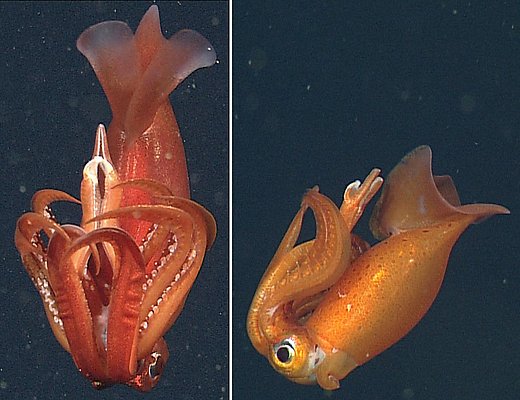

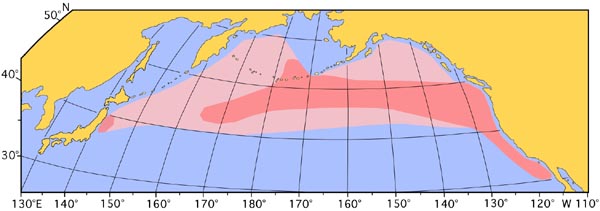
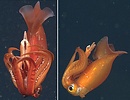


 Go to quick links
Go to quick search
Go to navigation for this section of the ToL site
Go to detailed links for the ToL site
Go to quick links
Go to quick search
Go to navigation for this section of the ToL site
Go to detailed links for the ToL site